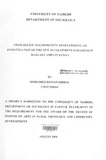| dc.description.abstract | A succession of armed conflicts in the Horn of Africa and the Great Lakes Region have
resulted in the flight of millions of people in search of safety, with some of them ending in
refugee camps. Several aid agencies under the umbrella organization United Nations High
Commissioner for Refugees (UNHCR) are responsible for humanitarian assistance and
protection of these refugees. This research was carried out at the Dadaab Refugee Camp of the
North Eastern Province of Kenya.
Included in this work is the new development paradigm shift from relief to community
development in Dadaab camps in Kenya. The objectives of the study were to examine the
patterns of adoption of the new skills, characteristics of the adopters, new activities that those
with skills have engaged in, the perception of the refugees on the shift from relieve to
development and establishing whether development activities at the Dadaab camps enhance
self-reliance. This study was informed by the theories of dependency, rational choice and
conflict and dependent development.
Primary and secondary data collection methods were applied to get the appropriate data for
analysis. This included interviews, questionnaires, direct observation, schedules, focus group
discussions, library research, project returns and reports.
The humanitarian agencies have engaged. in various Capacity building initiatives to empower
the refugees for self-reliance on repatriation resettlement or integration.
The study found out that the shift from relief to development in the Dadaab Refugee Camp had
been necessitated by the increased donor fatigue and the shift of world attention to new
emergencies like the Darfur crisis, Tsunami devastation in East South Asia, and the American
Hurricanes of Katrina and Wilma. Although the shift to community development is a good
idea, it has been introduced prematurely. The refugees were not consulted for the purpose of
owning the new development paradigm; hence initiative may not take off as anticipated by the
humanitarian agencies.
Further findings revealed that refugees have received skills training through aid agencies in
teaching, tailoring, typing, welding, business management, computer education, leadership
skills, leather work and carpentry.
The study concludes that for the new shift to succeed, the aid agencies need to involve all the
stakeholders in all the major stages in the shift. These stages include project conception,
assessment, planning, design, implementation, monitoring and evaluation | en |

